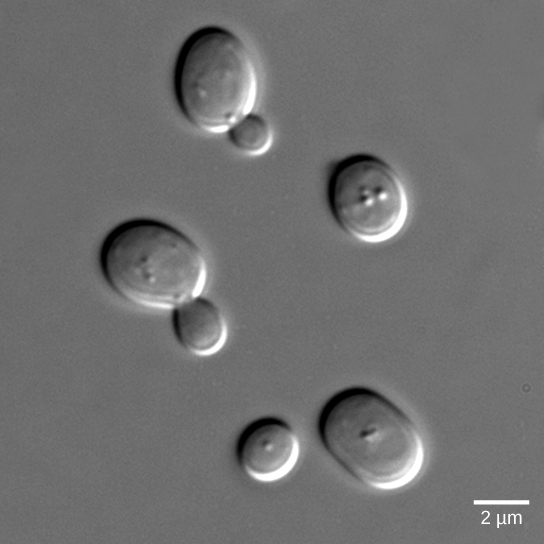9.13: Signaling in Yeast
- Page ID
- 43620

Yeasts are eukaryotes (fungi), and the components and processes found in yeast signals are similar to those of cell-surface receptor signals in multicellular organisms. Budding yeasts are able to participate in a process that is similar to sexual reproduction that entails two haploid cells (cells with one-half the normal number of chromosomes) combining to form a diploid cell (a cell with two sets of each chromosome, which is what normal body cells contain). Figure 1, shows a micrograph of this process. The budding Saccharomyces cerevisiae yeast cells are visualized using differential interference contrast microscopy, a light microscopy technique that enhances the contrast of the sample.
In order to find another haploid yeast cell that is prepared to mate, budding yeasts secrete a signaling molecule called mating factor. When mating factor binds to cell-surface receptors in other yeast cells that are nearby, they stop their normal growth cycles and initiate a cell signaling cascade that includes protein kinases and GTP-binding proteins that are similar to G-proteins.
Cellular Communication in Yeasts
The first life on our planet consisted of single-celled prokaryotic organisms that had limited interaction with each other. While some external signaling occurs between different species of single-celled organisms, the majority of signaling within bacteria and yeasts concerns only other members of the same species. The evolution of cellular communication is an absolute necessity for the development of multicellular organisms, and this innovation is thought to have required approximately 2.5 billion years to appear in early life forms.
Yeasts are single-celled eukaryotes, and therefore have a nucleus and organelles characteristic of more complex life forms. Comparisons of the genomes of yeasts, nematode worms, fruit flies, and humans illustrate the evolution of increasingly complex signaling systems that allow for the efficient inner workings that keep humans and other complex life forms functioning correctly.
Kinases are a major component of cellular communication, and studies of these enzymes illustrate the evolutionary connectivity of different species. Yeasts have 130 types of kinases. More complex organisms such as nematode worms and fruit flies have 454 and 239 kinases, respectively. Of the 130 kinase types in yeast, 97 belong to the 55 subfamilies of kinases that are found in other eukaryotic organisms. The only obvious deficiency seen in yeasts is the complete absence of tyrosine kinases. It is hypothesized that phosphorylation of tyrosine residues is needed to control the more sophisticated functions of development, differentiation, and cellular communication used in multicellular organisms.
Because yeasts contain many of the same classes of signaling proteins as humans, these organisms are ideal for studying signaling cascades. Yeasts multiply quickly and are much simpler organisms than humans or other multicellular animals. Therefore, the signaling cascades are also simpler and easier to study, although they contain similar counterparts to human signaling.[1]
Practice Question
What characteristics make yeasts a good model for learning about signaling in humans?
[practice-area rows=”2″][/practice-area]
[reveal-answer q=”285048″]Show Answer[/reveal-answer]
[hidden-answer a=”285048″]Yeasts are eukaryotes and have many of the same systems that humans do; however, they are single-celled, so they are easy to grow, grow rapidly, have a short generation time, and are much simpler than humans.[/hidden-answer]
- G. Manning, G.D. Plowman, T. Hunter, S. Sudarsanam, “Evolution of Protein Kinase Signaling from Yeast to Man,” Trends in Biochemical Sciences 27, no. 10 (2002): 514–520. ↵
Contributors and Attributions
- Biology. Provided by: OpenStax CNX. Located at: http://cnx.org/contents/185cbf87-c72e-48f5-b51e-f14f21b5eabd@10.8. License: CC BY: Attribution. License Terms: Download for free at http://cnx.org/contents/185cbf87-c72...f21b5eabd@10.8

